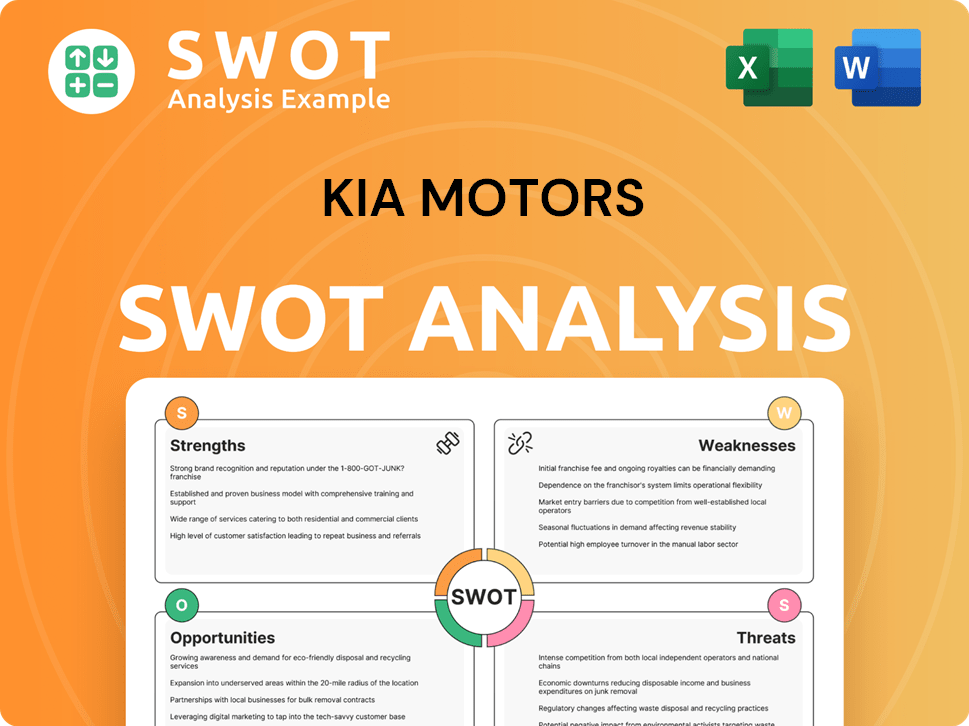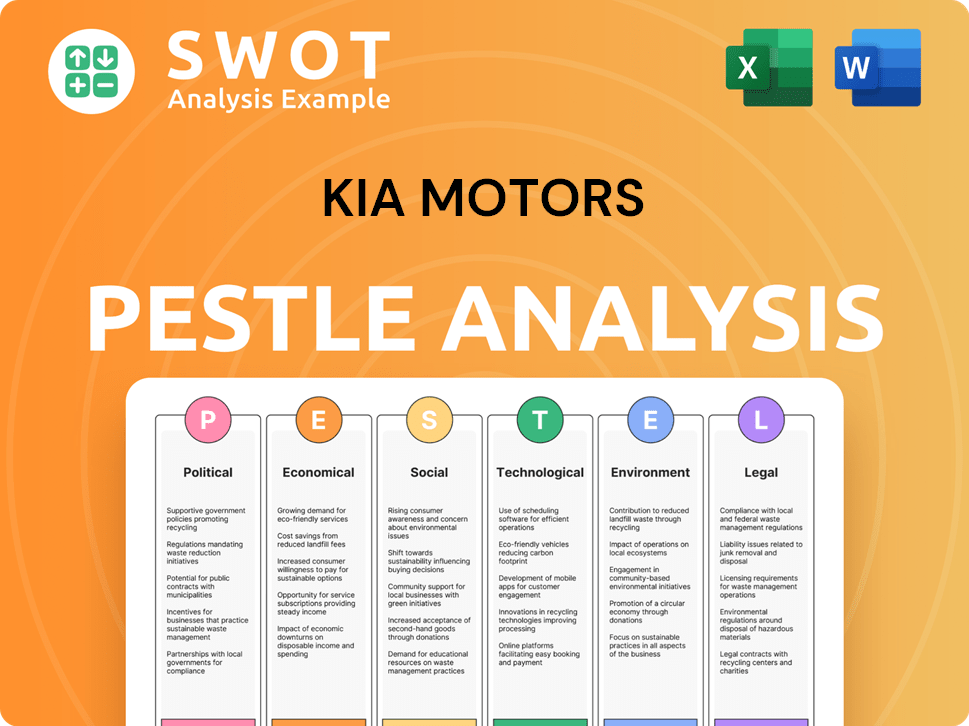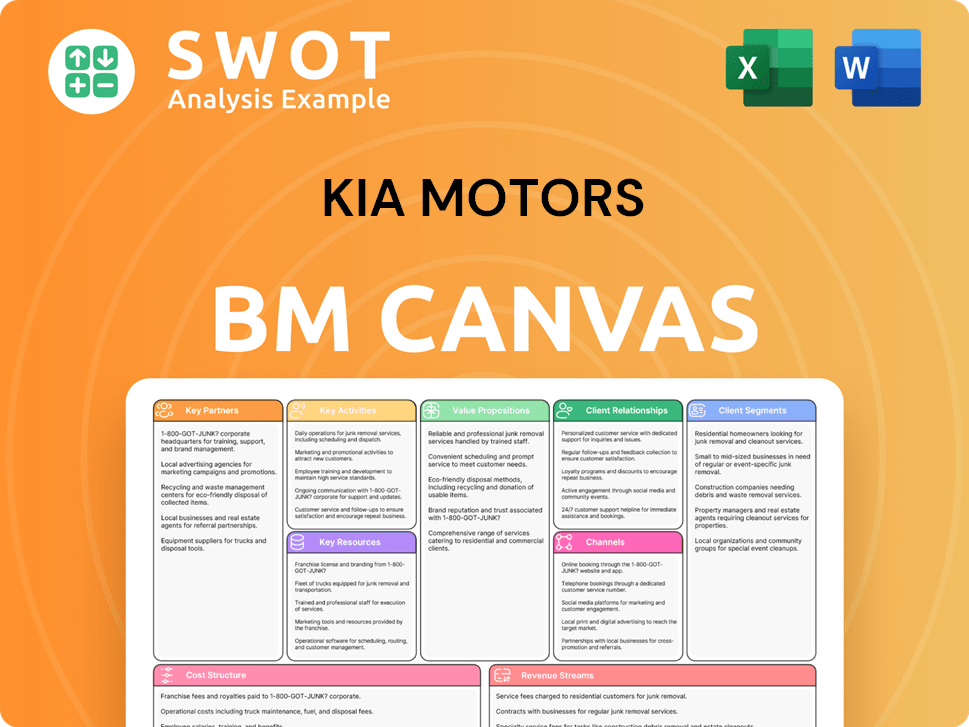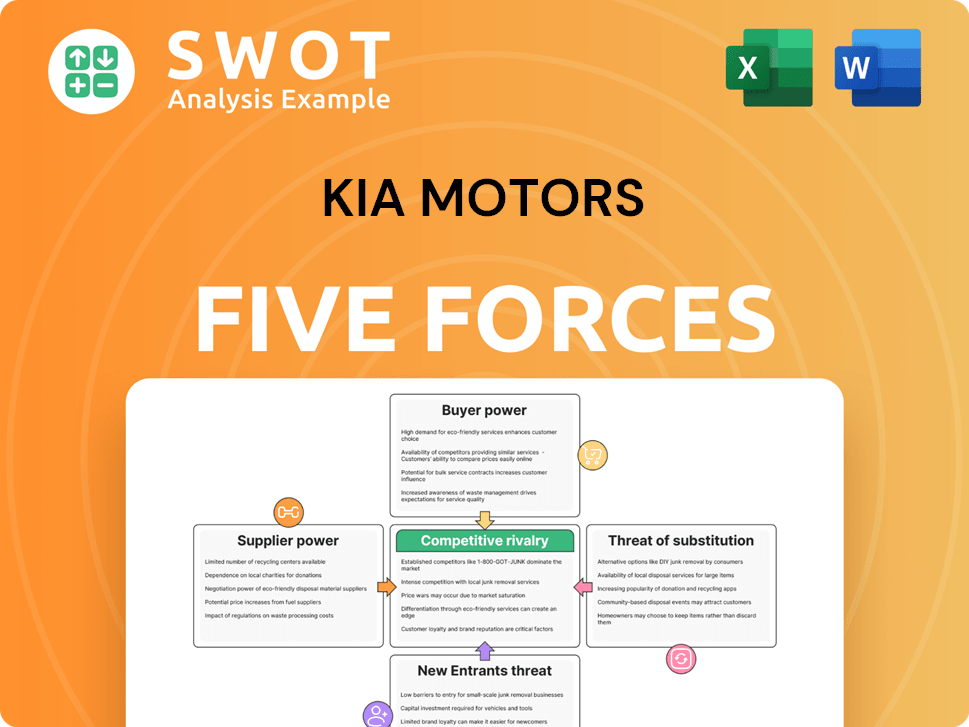Kia Motors Bundle
How did Kia Motors rise to global prominence?
From its modest beginnings in South Korea, Kia Motors has become a global automotive titan, but how did this transformation happen? The Kia Motors SWOT Analysis reveals the strategic moves that propelled this Korean car manufacturer to the forefront of the automotive industry. Discover the fascinating story of Kia, its evolution, and its journey to becoming a household name.

Kia's story, a brief history of Kia Motors company, began in 1944 as Kyungsung Precision Industry, initially focusing on bicycle parts. This early focus laid the foundation for its later expansion into the automotive industry. This article will delve into the Kia history, exploring key moments and strategic shifts that shaped the Kia brand and its impressive rise to global presence.
What is the Kia Motors Founding Story?
The Kia Motors story began on December 11, 1944, under the name Kyungsung Precision Industry. Focused on addressing the need for basic transportation in post-war Korea, the company's founders initiated their journey by manufacturing bicycle parts.
This early venture laid the groundwork for the production of Korea's first domestic bicycle, the Samchully, in 1951. This marked a significant achievement, demonstrating the company's adaptability and its capacity to meet the demands of the market.
The initial funding for Kyungsung Precision Industry likely came from bootstrapping and local investments, common for businesses in the post-war era. The company's early development was significantly shaped by Korea's economic environment, which was undergoing reconstruction and development, creating a favorable context for industries providing essential goods and services.
Kyungsung Precision Industry's initial focus was on bicycle parts, evolving into complete bicycle production.
- The company's founders saw a critical need for transportation in post-war Korea.
- Their first product was handmade bicycle parts.
- The Samchully, Korea's first domestic bicycle, was introduced in 1951.
- The economic climate of post-war Korea greatly influenced the company's establishment.
The Marketing Strategy of Kia Motors has evolved significantly since its early days, reflecting the company's growth and expansion.
Kia Motors SWOT Analysis
- Complete SWOT Breakdown
- Fully Customizable
- Editable in Excel & Word
- Professional Formatting
- Investor-Ready Format

What Drove the Early Growth of Kia Motors?
The early growth and expansion of Kia Motors, formerly Kyungsung Precision Industry, marked a significant transition from its bicycle manufacturing origins. This period saw the company progressively entering the automotive industry. Kia's strategic moves and partnerships were crucial to its development as a leading Korean car manufacturer. The company's ability to adapt and diversify its offerings laid the groundwork for its future success.
In 1957, Kia began producing motorcycles under license from Honda, representing an early step into the automotive sector. This move allowed Kia to gain experience in vehicle manufacturing processes. The production of motorcycles provided a foundation for future automotive endeavors within the Kia brand.
The early 1960s saw Kia producing three-wheeled utility vehicles, like the K-360 in 1962. These vehicles were designed for commercial use, establishing Kia's presence in the light commercial vehicle market. This expansion helped Kia to diversify its product line and cater to different market needs.
In 1974, Kia launched its first passenger car, the Brisa, based on the Mazda Familia. This marked a pivotal moment in Kia history, signifying its official entry into the passenger car segment. The introduction of the Brisa was a key strategic move, expanding Kia's product range.
During this period, Kia expanded its manufacturing capabilities to support increased production volumes. New facilities were established to meet the growing demand for its vehicles. This expansion was crucial for the company's growth in the automotive industry. For more details on Kia's financial performance and business model, consider reading about the Revenue Streams & Business Model of Kia Motors.
Kia Motors PESTLE Analysis
- Covers All 6 PESTLE Categories
- No Research Needed – Save Hours of Work
- Built by Experts, Trusted by Consultants
- Instant Download, Ready to Use
- 100% Editable, Fully Customizable

What are the key Milestones in Kia Motors history?
The Kia Motors journey, a prominent player in the automotive industry, has been marked by significant milestones, reflecting its evolution from a small manufacturer to a global automotive powerhouse. From its early years to its current status as a leading Korean car manufacturer, Kia's history is a testament to its resilience and strategic vision.
| Year | Milestone |
|---|---|
| 1944 | The company was founded in South Korea as Kyungsung Precision Industry, initially manufacturing steel tubing and bicycle parts. |
| 1974 | Kia Motors began its automotive journey by assembling the Fiat 124 under license. |
| 1992 | Kia launched the Sephia, its first independently designed vehicle, showcasing its growing engineering capabilities. |
| 1998 | Hyundai Motor Company acquired a controlling interest in Kia, forming the Hyundai-Kia Automotive Group, after Kia declared bankruptcy due to the Asian Financial Crisis. |
| 2006 | Peter Schreyer was appointed as Chief Design Officer, initiating a design revolution with the 'Tiger Nose' grille. |
| 2024 | Kia achieved record global sales of 3.1 million units, demonstrating strong market performance. |
Kia has consistently embraced innovation to stay competitive in the automotive industry. A key innovation was the introduction of the 'Tiger Nose' grille, which became a signature design element, significantly enhancing brand recognition. Furthermore, Kia's aggressive push into the electric vehicle (EV) market with models like the EV6 and EV9 showcases its commitment to sustainable mobility solutions.
The appointment of Peter Schreyer in 2006 led to a complete overhaul of Kia's design language. The 'Tiger Nose' grille became a distinctive feature.
Kia has invested heavily in electric vehicles, with models like the EV6 and EV9. These models have received critical acclaim and contributed to sales growth.
Kia integrates advanced driver-assistance systems, enhancing safety and driving experience. These systems include features like lane-keeping assist and adaptive cruise control.
Modern Kia vehicles feature advanced connectivity and infotainment systems. These include touchscreen displays, smartphone integration, and over-the-air updates.
Kia focuses on developing efficient powertrains, including hybrid and plug-in hybrid options. These technologies improve fuel economy and reduce emissions.
Kia has significantly improved the quality and reliability of its vehicles. This has led to higher customer satisfaction and brand reputation.
Despite its successes, Kia has faced several challenges throughout its history. The Asian Financial Crisis in 1997 led to bankruptcy, requiring significant restructuring and the acquisition by Hyundai. Currently, Kia faces intense competition in the EV market and supply chain disruptions.
The 1997 Asian Financial Crisis led to Kia declaring bankruptcy. This resulted in a major restructuring and the eventual acquisition by Hyundai.
The EV market is highly competitive, with established automakers and new entrants vying for market share. This requires continuous innovation and strategic investments.
Global supply chain disruptions have impacted the automotive industry. Kia has had to manage these disruptions to maintain production and meet demand.
Consumer preferences are constantly evolving, with a growing demand for electric and hybrid vehicles. Kia must adapt its product offerings to meet these changing needs.
Stringent environmental regulations and safety standards require Kia to invest in new technologies. Compliance with these regulations is crucial for market access.
Economic downturns can affect consumer spending on vehicles. Kia must manage its production and sales strategies to navigate economic uncertainties.
Kia Motors Business Model Canvas
- Complete 9-Block Business Model Canvas
- Effortlessly Communicate Your Business Strategy
- Investor-Ready BMC Format
- 100% Editable and Customizable
- Clear and Structured Layout

What is the Timeline of Key Events for Kia Motors?
The Kia Motors journey is a compelling story of growth and transformation within the automotive industry. From its humble beginnings as a bicycle manufacturer to its current status as a global automotive powerhouse, the Kia history reflects significant milestones and strategic shifts. This Korean car manufacturer has consistently evolved, adapting to market demands and technological advancements, establishing itself as a prominent Kia brand.
| Year | Key Event |
|---|---|
| 1944 | Founded as Kyungsung Precision Industry, initially manufacturing bicycle parts. |
| 1957 | Began manufacturing of the first motorcycle, the C-100. |
| 1974 | Started producing the Brisa, its first car, under license from Mazda. |
| 1980s | Navigated challenges including government regulations and economic downturns. |
| 1990s | Expanded globally and was acquired by Hyundai Motor Company in 1998. |
| 2000s | Focused on design and quality, leading to significant improvements in brand perception. |
| 2010s-2020s | Expanded its electric vehicle (EV) lineup and continued to innovate in design and technology. |
The Kia Motors is heavily investing in electric vehicles. The EV6 and EV9 models are crucial to this strategy. The company aims to increase its EV sales significantly, targeting a substantial market share in the coming years. This expansion is supported by investments in battery technology and charging infrastructure.
The Kia Motors continues to strengthen its global presence, especially in North America and Europe. The company is focusing on expanding its manufacturing capabilities. It also aims to enhance its brand image through strategic marketing campaigns and partnerships.
The Kia Motors is integrating advanced technologies, including autonomous driving features and enhanced connectivity. The company is also investing in research and development to stay ahead of the curve. This includes exploring new materials and manufacturing processes to improve vehicle performance and sustainability.
The company is committed to reducing its environmental impact through sustainable manufacturing practices. This includes using recycled materials and reducing emissions. The Kia brand is also focused on developing eco-friendly vehicles. It is also investing in renewable energy sources for its manufacturing plants.
Kia Motors Porter's Five Forces Analysis
- Covers All 5 Competitive Forces in Detail
- Structured for Consultants, Students, and Founders
- 100% Editable in Microsoft Word & Excel
- Instant Digital Download – Use Immediately
- Compatible with Mac & PC – Fully Unlocked

Related Blogs
- What is Competitive Landscape of Kia Motors Company?
- What is Growth Strategy and Future Prospects of Kia Motors Company?
- How Does Kia Motors Company Work?
- What is Sales and Marketing Strategy of Kia Motors Company?
- What is Brief History of Kia Motors Company?
- Who Owns Kia Motors Company?
- What is Customer Demographics and Target Market of Kia Motors Company?
Disclaimer
All information, articles, and product details provided on this website are for general informational and educational purposes only. We do not claim any ownership over, nor do we intend to infringe upon, any trademarks, copyrights, logos, brand names, or other intellectual property mentioned or depicted on this site. Such intellectual property remains the property of its respective owners, and any references here are made solely for identification or informational purposes, without implying any affiliation, endorsement, or partnership.
We make no representations or warranties, express or implied, regarding the accuracy, completeness, or suitability of any content or products presented. Nothing on this website should be construed as legal, tax, investment, financial, medical, or other professional advice. In addition, no part of this site—including articles or product references—constitutes a solicitation, recommendation, endorsement, advertisement, or offer to buy or sell any securities, franchises, or other financial instruments, particularly in jurisdictions where such activity would be unlawful.
All content is of a general nature and may not address the specific circumstances of any individual or entity. It is not a substitute for professional advice or services. Any actions you take based on the information provided here are strictly at your own risk. You accept full responsibility for any decisions or outcomes arising from your use of this website and agree to release us from any liability in connection with your use of, or reliance upon, the content or products found herein.